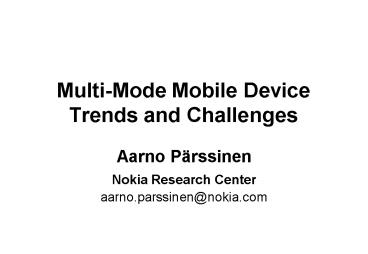MultiMode Mobile Device Trends and Challenges - PowerPoint PPT Presentation
1 / 21
Title:
MultiMode Mobile Device Trends and Challenges
Description:
Multi-Mode Mobile Device Trends and Challenges. Aarno P rssinen. Nokia Research Center ... aarno.parssinen_at_nokia.com. Applications for mobile consumers ... – PowerPoint PPT presentation
Number of Views:63
Avg rating:3.0/5.0
Title: MultiMode Mobile Device Trends and Challenges
1
Multi-Mode Mobile Device Trends and Challenges
- Aarno Pärssinen
- Nokia Research Center
- aarno.parssinen_at_nokia.com
2
Applications for mobile consumers
- Connecting people and communities
- Voice call and messaging
- Email, web 2.0
- Broadband multimedia
- Personal content sharing
- Broadcast/Webcast
- Interactive multimedia
- Data synchronization, mobile enhancements
- Location based services
- Ubicomm
3
Radios for various purposes
- Protocols
- Cellular, BT, WLAN
- Broadcast (FM mobile TV)
- Location (GPS)
- Broad-band mobility (LTE/WiMax)
- Local applications and services (ULP BT / RFID)
- Scalability to different markets
- Different market regions segments
- Capacity towards higher data rates
- Connect everything
4
Origins of front-end parameters
- Protocols, control plane and RF schedule
- Antenna interface ( of bands, RF performance)
- ASIC interface
5
Radio spectrum in mobile use
Most bands are regional or contain regional
sub-bands
6
Potential RF Variants for Global Coverage
1) Only one standard for the application given 2)
Band groups in MB-OFDM
7
Wide-Area Broadband
1) WiMAX mobile profile, 2) Fractional Frequency
Reuse
8
Multi-standard RF paradigm
- Antenna-to-antenna isolation finite
- All radios are coupled
- Strong internal interferers in the device
- Additional non-standard specifications
- blocking and harmonics from another TX
- wide-band noise from other TX
- intermodulation due to other internal TX and
external/internal blocker - several clock domains
9
GPS Example
- GSM uplink with maximum output power _at_900.0 MHz
- WLAN transmitting with maximum power _at_2475.5 MHz
10
IIP2 requirement for GPS
- Intermodulation due to own TX power and external
blocker
GPS N(RX) -108 dBm IMD,max (RX) -123
dBm GSM P(TX) 33 dBm P(TX _at_GPS ANT) 18
dBm WLAN _at_1m P(TX) 20 dBm P(TX _at_GPS ANT) -20
dBm IMD2/GPS BW ratio 8 GPS IMD2, max
tot -114 dBm IIP2_at_ANT, specs 112
dBm G(ANT-MIXER) 20 dB IIP2(mixer) 50 dBm
-gt L(GSM)L(WLAN) 62 dB
LNA response
LNA response
11
Example Wide-band noise
WCDMA P(RX) -117 dBm N(RX) _at_3.84MHz -99
dBm WLAN P(TX) 20 dBm P(TX _at_WCDMA ANT) 5
dBm -67 dBm/Hz N(WB) specs -40 dBr -107
dBm/Hz N(WB) _at_WCDMA band -41 dBm N(WB)
requirement -114 dBm ?N(WB) 73 dB
WCDMA
WLAN
WLAN spectrum mask
?N(WB)
12
Interference requirements
- TX source and RX victim
TX
RX
Design margin
critical
small
moderate
large
13
Key performance elements
- Antenna isolation
- RX Filtering and TX transmission mask
- Sensitivity especially in cellular communications
and GPS - Enhanced receiver linearity
- Getting power also to aether
- Power consumption
- Continuous connection to internet through
different protocols - Minimize losses in the front-end
14
Holistic integration
- Antenna placement
- Front-end losses especially at band edges
- Robustness (mismatch, thermal, )
- Stable impedance environment for filters
- Maintain antenna efficiency (loading)
- Human interaction
15
Getting power out (Examples)
3) Specs 24 (1/-3) dBm 4) Peak values average
less due to pwr ctrl
1) Wiring and FE loss at band (edge) 2)
Reflection loss and PA load pull
16
State-of-the-art Device
- WLAN 802.11b/g
- WCDMA/HSDPA 2100
- 4-band EDGE
- BT 2.0
- FM
- GPS
- Volume 96 cm3
- Weight 128 g
WCDMA GSM RF
GSM PA
WCDMA PA
MODEM
EM AUDIO
FM
APPLICATION PROCESSOR
WLAN
BT
GPS
17
It is just beginning
- Ultimate complexity
- of bands systems
- Ultimate performance
- Cellular GPS
- Ultimate functionality
- Antenna, filters, PA
- Power detector, coupler, etc.
- System controls
- Performance controls
- Ultimate integration
- Module Packaging
18
Scenario towards full SDR
- Generic SDR RF BB will make it ?
- SDR front-ends
- System performance
- Antenna placement
- FE adjustability (up to 10-20 bands)
- Separate front-ends or one switched ?
- SDR ASIC
- Is interference still tolerable?
- Losses to antennas
- Flexible spectrum usage
2G 3G
GPS
WLAN
BT
DVB-H
FM
WLAN DIV
3G DIV
19
Control challenge
- Interfaces in multimodal operation
20
Conclusion
- Multi-standard radio devices play a major role in
mobile devices excluding the simplest low-end
devices - Increased number of RF bands and wide-band
systems will make the scene even more complex - SDR platform must meet product performance,
scalability, form factor and control requirements
in a hostile local radio environment - RF from silicon to aether and back is a challenge
beyond the SDR ASIC integration - Dependencies in RF frequency agility require
holistic co-design of system, ASIC and front-end
21
(No Transcript)































